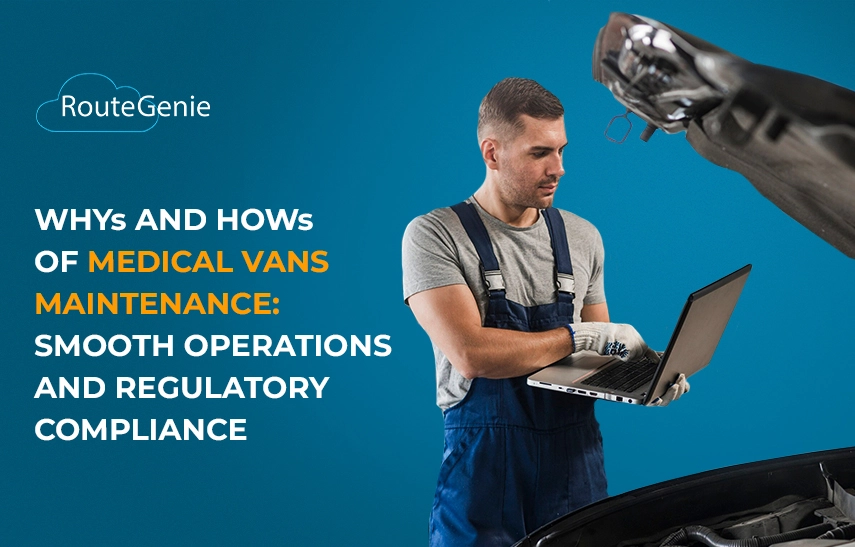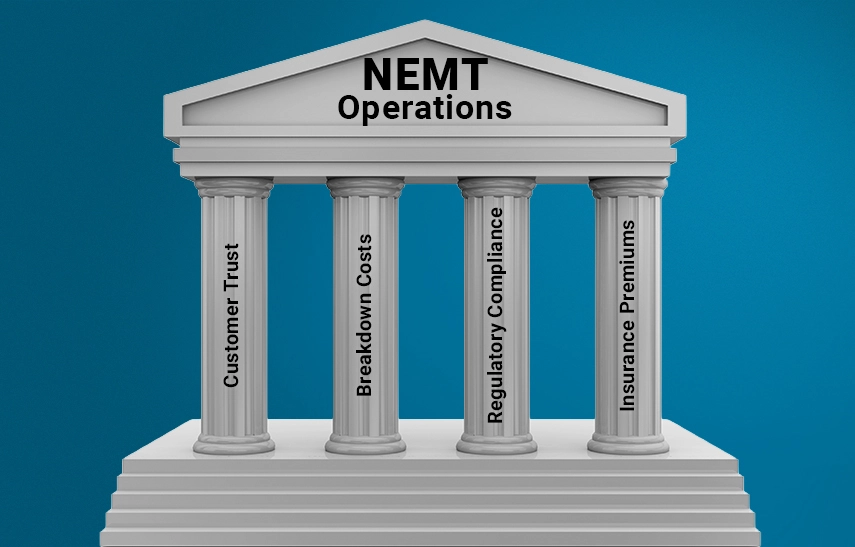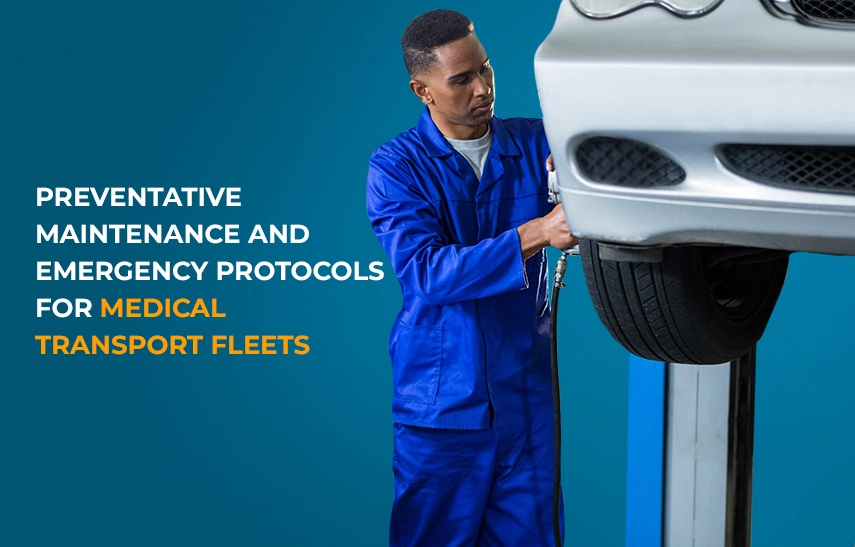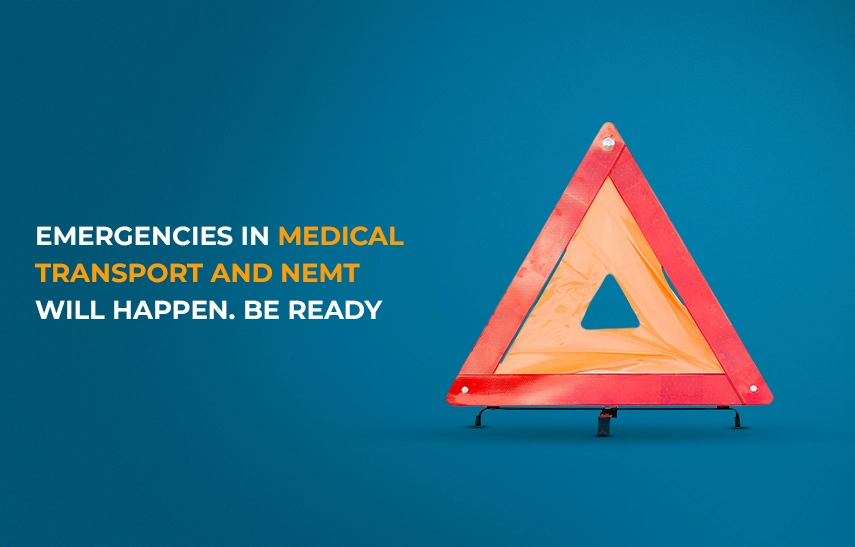Whys and Hows of Medical Vans Maintenance: Smooth Operations and Regulatory Compliance

When your NEMT vehicle or a medical van breaks down with a dialysis passenger aboard, the consequences extend far beyond a simple repair bill. You're facing missed medical appointments, potential health complications for the passenger, regulatory scrutiny, and damaged relationships with healthcare providers. Effective fleet maintenance isn't just about keeping vehicles running; it's about ensuring uninterrupted, life-sustaining medical transportation services while building a profitable, compliant business with strong partner relationships.
Today, we will address the main reasons why you should pay great attention to the state of your medical van service or a non-emergency medical transport (NEMT) fleet. And as usual, we will suggest actionable strategies on how to prevent such unexpected breakdowns that carry both financial and reputational implications.
Contents:
- The Pillars of Successful Medical Transport (NEMT) Operations
- Preventive Maintenance and Emergency Protocols for Medical Transport Fleets
- Emergencies in Medical Transport and NEMT Will Happen. Be Ready
- Using Medical Transport & NEMT Software to Streamline All Maintenance Aspects
- Bottom Line: Why Medical Transport Maintenance Defines Reliability and Profitability
The Pillars of Successful Medical Transport (NEMT) Operations
 Building Trust with Your Customers: Let's be honest, your medical transport or NEMT service lives or dies by reliability. Healthcare providers count on you to get their passengers to critical appointments like dialysis and chemo. Miss just one of those, and you've damaged a relationship that took years to build. Most contracts not only expect on-time performance but also clearly spell out that providers must deliver 95-99% on-time service to meet the expectations of the MCO. Unfortunately, once the confidence in you is lost, winning it back is an uphill battle that can take years. Here are some Tips from RouteGenie on how to achieve on-time NEMT performance.
Building Trust with Your Customers: Let's be honest, your medical transport or NEMT service lives or dies by reliability. Healthcare providers count on you to get their passengers to critical appointments like dialysis and chemo. Miss just one of those, and you've damaged a relationship that took years to build. Most contracts not only expect on-time performance but also clearly spell out that providers must deliver 95-99% on-time service to meet the expectations of the MCO. Unfortunately, once the confidence in you is lost, winning it back is an uphill battle that can take years. Here are some Tips from RouteGenie on how to achieve on-time NEMT performance.
The Real Cost of Breakdowns: An out-of-service medical transport vehicle, or NEMT van, that can't make a scheduled trip is not only generating repair bills but also effectively harming your entire bottom line. The industry data shows that every single day the vehicle stays idle, the business might be losing hundreds of dollars. In fact, if all of the expenses are accounted for, the figure can go into thousands. And here's the kicker: emergency repairs are never cheap; they cost several times more than regular maintenance, because now you're dealing with emergency problems and demanding a rush job at the autoshop. On top of that, you either accept penalties from Medicaid or attempt to dodge them by catching up on the missed appointments by renting replacement vehicles and paying drivers overtime.
Staying on the Right Side of Regulations: For medical transport providers, there’s no wiggle room when it comes to maintenance compliance. The failsafes installed by the regulators require your drivers to fill out Daily Vehicle Inspection Reports (DVIRs) every single shift. These reports document any issues and force owners to fix the problems before the vehicle returns on the road. What about all your wheelchair lifts and other accessibility equipment? All medical vans, wheelchair lifts, and mobility aids need to meet ADA standards. Get caught cutting corners and you could face fines in the thousands. Keep doing it, and you might lose your license or contracts entirely.
Your Insurance Premiums Depend on It: Insurance companies pay close attention to how well you take care of your fleet. If you don't keep good records of your maintenance, you might have to pay more for insurance or, even worse, have your claims denied if an accident happens with equipment you didn't take care of. But if you turn that around, medical transport operators with good preventive maintenance programs can often get their insurers to lower their rates by 8–20%. So, maintenance isn't just about keeping cars safe; it is a part of a strategy to maximize profits and protect your bottom line in all areas, from operations to contracts to insurance costs.
Preventive Maintenance and Emergency Protocols for Medical Transport Fleets
 How you approach maintenance, staying ahead of problems, or just fixing things when something fails makes or breaks your medical transport or NEMT business. For any medical transport fleet, a preventive maintenance schedule ensures predictable costs. You can plan downtime around your slowest periods, and your vehicles actually show up when you need them. It's not exciting, but it works.
How you approach maintenance, staying ahead of problems, or just fixing things when something fails makes or breaks your medical transport or NEMT business. For any medical transport fleet, a preventive maintenance schedule ensures predictable costs. You can plan downtime around your slowest periods, and your vehicles actually show up when you need them. It's not exciting, but it works.
Go the reactive route. Wait until something breaks to fix it, and you're basically gambling with your fleet. Suddenly, you've got a vehicle down at the worst possible time, you're paying triple for emergency repairs, and you're scrambling to cover trips. That's not just expensive, it's the kind of chaos that tanks your reputation with healthcare providers who depend on you.
Preemptive vs. Emergency Maintenance Impact
A study found that every dollar spent on preventive maintenance saves $3-9 on reactive repairs through reduced emergency repairs, extended vehicle life, lower insurance costs, and improved fuel efficiency. The approach focuses on addressing potential issues before they become problems through regular oil changes, brake inspections, tire rotations, and system checks.
| Category | Preemptive Maintenance | Emergency Maintenance |
| Safety | Regular inspections reduce accident risk; protect passengers, drivers, and reduce liability | Failures create sudden safety hazards for vulnerable passengers and staff |
| Service Reliability | 99%+ on-time performance; reliable trips sustain healthcare contracts and client trust | Frequent breakdowns cause late/missed trips; erode trust and risk contract loss |
| Compliance | Consistent DVIR checks and inspections simplify compliance; fewer violations and penalties | Higher risk of failed inspections, citations, and possible suspension of licenses |
| Cost Management | Predictable budgets; typically 25–40% lower lifetime costs | Higher costs from emergency callouts, overtime labor, rush parts, and penalties |
| Downtime | Minimal, planned around off-peak hours; disruptions are controlled | Unplanned downtime often strikes at peak demand; extended delays waiting for repairs |
| Asset Longevity | Vehicles regularly exceed 200,000+ miles with proper care | Neglect causes premature wear, shortening the useful life of fleet assets |
| Insurance & Risk | Lower accident frequency reduces claims and can lower premiums over time | Frequent claims increase insurance costs and liability exposure |
| Operational Efficiency | Properly tuned engines and drivetrains reduce fuel spend | Poorly maintained vehicles burn more fuel, raising costs and emissions |
| Workforce Satisfaction | Reliable, comfortable vehicles improve driver satisfaction and retention | Frequent breakdowns frustrate drivers, increase stress, and push turnover higher |
| Customer Experience & Reputation | Passengers experience smoother rides and fewer cancellations; builds reputation for reliability and professionalism with healthcare partners | Unreliable service frustrates riders, damages patient experience; viewed as unreliable, jeopardizing contracts and provider relationships |
Emergencies in Medical Transport and NEMT Will Happen. Be Ready
 Yes, breakdown prevention is the best strategy in NEMT, but you have to accept the reality. In medical transport operations, even if you're doing everything right by following maintenance tips, vehicles and equipment can and probably will fail unexpectedly. The key is being ready when it happens so you can control the damage. When a vehicle breaks down during service, you're looking at up to $800 per day in lost revenue, but a solid emergency plan can cut that impact way down.
Yes, breakdown prevention is the best strategy in NEMT, but you have to accept the reality. In medical transport operations, even if you're doing everything right by following maintenance tips, vehicles and equipment can and probably will fail unexpectedly. The key is being ready when it happens so you can control the damage. When a vehicle breaks down during service, you're looking at up to $800 per day in lost revenue, but a solid emergency plan can cut that impact way down.
Here's what you need in place:
- Train your drivers on basic troubleshooting and how to keep passengers safe during breakdowns
- Line up emergency service providers ahead of time with locked-in rates and response times
- Have backup vehicles ready to go so appointments don't get missed, or partner with another medical transport or NEMT provider to pick up your orders.
- Make sure everyone knows the communication chain: dispatch, healthcare providers, passengers.
- Document everything thoroughly for insurance and regulatory reporting
After every breakdown, dig into what happened. You'll often find maintenance gaps you didn't know existed. When you see patterns in your emergency calls, that's your fleet telling you where your preventive maintenance program needs work. Fix those weak spots and watch your emergency incidents drop.
Using Medical Transport & NEMT Software to Streamline All Maintenance Aspects
Modern medical transport fleet software takes the guesswork out of fleet management. Instead of trying to track everything manually, let RouteGenie’s technology platform handle the heavy lifting.
Set It and Forget It Scheduling: The software watches your mileage, operating hours, and calendar dates, then automatically reminds you when maintenance is due. No more spreadsheets or sticky notes, just notifications when it's time for oil changes, brake checks, or inspections. You'll never miss a maintenance window again.
Digital Inspection Reports: Say goodbye to paper DVIRs. Drivers complete their daily inspections right on their phones or tablets using standardized checklists. They can snap photos of any problems, flag vehicles as out-of-service instantly, and the system automatically alerts your maintenance team. Best part? The software won't let dispatch assign a flagged vehicle to a trip.
Track Every Dollar and Part: See exactly what each vehicle is costing you in repairs and parts. The software shows you which vehicles are becoming money pits, making it easier to decide when to fix versus replace. Plus, it helps you spot opportunities to save – like bulk ordering parts or negotiating better rates with your go-to vendors.
Compliance Made Simple: When DOT shows up for an inspection or your insurance company wants an audit, everything's ready to go. All your maintenance records, certifications, and compliance documents are stored digitally with timestamps. No more panic-searching through file cabinets for that one missing form.
Know What's Happening Right Now: Advanced systems connect to your vehicles' onboard computers to monitor engine health, fuel efficiency, and driver behavior in real time. When something's off, you get an alert immediately. That means you can fix small problems before they turn into roadside breakdowns.
Bottom Line: Why Medical Transport Maintenance Defines Reliability and Profitability
In medical transport and NEMT, the difference between a seamless, stress-free patient ride and a difficult, costly breakdown comes down to the condition of your vehicles. A single missed trip can compromise passenger safety, jeopardize your contracts, and tarnish your reputation. But with the right maintenance program and advanced medical transport and NEMT software like RouteGenie, you can leverage vehicle maintenance to become a superpower for your business.
How about trigger-based automated maintenance reminders, digital inspections performed with ease, real-time alerts about your vehicles' health, and compliance reports at your touch? Sure, it will save your business money on repairs, but more importantly, it will allow you to keep your timeliness in every ride, ensure consistent revenue for your business, and strengthen your trust with healthcare operators. If your vehicles are reliable, your service shines, your passengers are safe, and your business continues to thrive.
About the author

Serhii Taborovskyi is the creator and author of the Automotive Territory YouTube Channel, with 300,000 subscribers and counting. He is an avid automotive enthusiast and a fan of any and all motorized vehicles. Serhii is a visiting author at RouteGenie, sharing his expertise for the benefit of the NEMT community.
The author assumes no responsibility or liability for any errors or omissions in the content of this site. The information contained in this site is provided on an "as is" basis with no guarantees of completeness, accuracy, usefulness or timeliness.